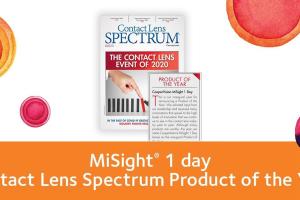By Matt Kauffman, OD

The FDA approval* of CooperVision’s MiSight® 1 day contact lenses in November 2019 was a game changer in the field of myopia management. Clinicians now had another option in their toolbox that would potentially provide a reduction in a child’s myopia progression.†1 Since MiSight® 1 day has a different optical design compared to other daily disposable soft contact lenses, the next monumental task was to properly educate thousands of clinicians across the country about myopia management and how to incorporate the MiSight® into their clinics and manage these children with myopia.
As a result, CooperVision launched the Brilliant Futures™ learning center at MiSightPro.com, which is an online platform comprised of five lessons and a certification exam to start; and after certification, provides a library of other education and practice resources for certified practitioners. The certification lessons give clinicians an opportunity to learn about the myopia epidemic, how to interpret myopia research, analyze the MiSight® 1 day clinical study, identify risks and benefits of contact lens wear in children, and review the recommended prescribing guidelines for MiSight® 1 day myopia control contact lenses. Each lesson contains a discussion board, which provides the clinicians an opportunity to voice their thoughts and opinions about the five lesson topics described previously. Throughout the past year, hundreds of doctors have written more than 2,000 original posts with numerous replies on those discussion boards.
Below are several clinical pearls derived from the discussion board archives that can assist you when incorporating myopia management in your clinic.
Myopia management as a medically necessary treatment
The majority of parents may not think of contact lenses as a treatment option for young children. They may believe contact lenses are fit in teenagers solely to improve cosmesis or self-esteem, or for teens that play sports and cannot adequately wear spectacles during play. However, there is now a medically necessary reason2 to initiate myopia management treatment in children who have myopia and are progressing. Traditionally, the only treatment option for myopia was to educate parents that their child’s nearsightedness has progressed and provide an updated glasses prescription to them. However, now that we have myopia management treatment options, we must change our mindset and begin discussing myopia in terms of its medical implications, rather than just increasing the power of their glasses or contact lenses. Although parents may have myopia themselves, they may not fully realize the complications that can result from severe myopia.
Daily disposables are the ideal contact lenses modality for children
The majority of doctors who posted on the discussion board agree that a daily disposable soft contact lens is the ideal contact lens replacement modality for children. Daily disposables provide an improvement in comfort and compliance. Research has shown there is a lower risk of developing microbial keratitis in the 8-12 year old age range compared to other groups.3 The fact that MiSight® 1 day is FDA approved* to slow the progression of myopia in age appropriate children1† is an added benefit. These features are favorable when educating parents about myopia management and why a contact lens is medically necessary for their child even at a young age.
Marketing of myopia management to increase patient volume
Utilize your own electronic medical record (EMR) patient database to identify patients who are optimal candidates for myopia management. EMR search engines can be very powerful and allow a clinician to target myopia management education to patients who have myopia and in the prime myopia management treatment age; for reference MiSight® 1 day is FDA approved* for 8-12 years old. Metrics from ten clinicians selected at random from the Learning Center indicate approximately 15% of children in their practice ages 5-9 years old have myopia** and 29% of children in their practices ages 10-14 years old have myopia.** Those between 8 and 12 years of age from these groups are excellent candidates for a MiSight discussion and as an added benefit, no additional marketing funds must be spent to capture these patients. Children have a higher risk of developing myopia if one or both of their parents have myopia.4 Take an opportunity to ask parents who present to your office for their own eye exam about their children and if they have had a recent eye exam. You would be surprised the number of additional intraoffice myopia management referrals those conversations can generate and just how few children get comprehensive eye exams.
Importance of staff
Another area of focus to build your myopia management practice is staff education. We have long known that staff play a vital role in the operations of our clinics, and this philosophy still applies for myopia management. It is important that the staff have a general understanding about the following concepts: what myopia truly is, the risks of severe myopia, myopia management treatment options, how MiSight® 1 day specifically fits into the treatment regimen, and why it is important to educate all parents about the risks of severe myopia and the benefits of myopia management.1,2† By providing your staff the opportunity to continue the myopia management discussion after the patient and parent leave your exam room, you will increase the probability that the parent will schedule a myopia management evaluation for their child. The whole team needs to stay consistent in their messaging.
In summary
As myopia management becomes the standard of care, it is important to stay up to date on the latest clinician research and practice guidelines, not only from information published by CooperVision and their associated researchers and clinicians, but also continuing to learn from your colleagues. Remember to periodically visit the Brilliant Futures learning center to learn more clinical pearls from hundreds of clinicians around the country.
____________________________________________________________________________
* Indications for use: MiSight® 1 day (omafilcon A) soft (hydrophilic) contact lenses for daily wear are indicated for the correction of myopic ametropia and for slowing the progression of myopia in children with non-diseased eyes, who at the initiation of treatment are 8-12 years of age and have a refraction of -0.75 to -4.00 diopters(spherical equivalent) with ≤ 0.75 diopters of astigmatism. The lens is to be discarded after each removal.
†Compared with a standard single vision, 1 day lens over a three-year period.
**Data on file.
References:
1. Chamberlain P, et al. A 3-Year Randomized Clinical Trial of MiSight Lenses for Myopia Control. Optom Vis Sci. 2019;96(8):556-7. 2. Tideman JW, et al. Association of Axial Length With Risk of Uncorrectable Visual Impairment for Europeans With Myopia. JAMA Ophthalmol. 2016;134(12):1355-63.
2. Tideman JW et al. Association of axial length with risk of uncorrectable visual impairment for Europeans with myopia. JAMA Ophthalmol. 2016;134:1355-1363.]
3. Bullimore, M. The Safety of Soft Contact Lenses in Children. Optom Vis Sci 2017;94:638-646.
4. Mew-May Wu M, Edwards MH. The Effect of Having Myopic Parents: An Analysis of Myopia in Three Generations. Optometry and Vision Science. 1999 Jun 1;76(6):387–92.








